小学英语教案模板汇编(全册精选)
小学英语教育教学教案设计(精选9篇)

小学英语教育教学教案设计(精选9篇)(经典版)编制人:__________________审核人:__________________审批人:__________________编制单位:__________________编制时间:____年____月____日序言下载提示:该文档是本店铺精心编制而成的,希望大家下载后,能够帮助大家解决实际问题。
文档下载后可定制修改,请根据实际需要进行调整和使用,谢谢!并且,本店铺为大家提供各种类型的经典范文,如总结报告、心得体会、应急预案、会议记录、条据书信、合同协议、规章制度、教学资料、作文大全、其他范文等等,想了解不同范文格式和写法,敬请关注!Download tips: This document is carefully compiled by this editor. I hope that after you download it, it can help you solve practical problems. The document can be customized and modified after downloading, please adjust and use it according to actual needs, thank you!Moreover, our store provides various types of classic sample essays, such as summary reports, insights, emergency plans, meeting minutes, evidence letters, contract agreements, rules and regulations, teaching materials, essay summaries, and other sample essays. If you would like to learn about different sample formats and writing methods, please pay attention!小学英语教育教学教案设计(精选9篇)小学英语教育教学教案设计(精选9篇)2024-04-14 12:07:23小学英语教学设计(精选6篇)推荐度:小学英语教学设计范文最新6篇推荐度:热点范文英语(英文:English)是一种西日耳曼语支,最早被中世纪的英国使用,并因其广阔的殖民地而成为世界使用面积最广的语言。
小学英语教案汇编15篇

小学英语教案汇编15篇学校英语教案11课前预备1.教学挂图。
2.教学投影片。
3.教学录音磁带。
4.同学画图用白纸(老师预备)。
教学内容A Listen and find.1.本部分供应了一幅迷宫嬉戏图。
2.同学依据图和录音材料,找出图中人物要去的地方,并划线表示出来。
3.本部分通过听和找的活动,检测同学对本单元学习内容的听和认的状况。
4.为了降低听力材料的难度,每一项听力材料都是由两句话组成,先说某人去哪儿,再说乘什么交通工具。
5.图中的路线可以重复画。
B Let's make a mural and talk.1.本部分是一项同学自主活动。
同学以小组为单位,画一幅街道的图画(mural意为:壁画;天花板的装饰画)。
2.本部分供应了一幅同学画习作,供同学小组活动时参考。
3.同学绘画结束后,应对本组的作品集体进行描述,以此来检测自己对本单元学习内容的说的状况。
教学建议1.老师出示本课教学挂图,要求同学用“I can see....”语句对图画进行简洁描述。
2.老师请同学猜一猜画面上人物要去哪儿,引导同学说出在本单元学到的交际用语(留意:说本单元交际用语时需要换人称,老师可以关心同学说,如:老师说前半句Andy is,同学接后半句going to the supermarket.)。
3.同学听录音并画线。
该练习做完后要有反馈,老师要关心同学核对答案。
核对答案时同学可以相互交换课本,以逐步学会相互检查。
4.老师将同学分成4至5人一组,每组发一张白纸,要求同学以组为单位,画出想象中的街道。
老师也可以给出街道示意图(如下列图),请同学添加画面。
这项练习的另外一个做法是:课前布置任务,同学同样以组为单位,收集有关街道建筑、设施、车辆的图片,并将图片剪下来带到课堂。
课堂活动时,大家有选择的将自己收集到的图片贴在一起,组成街道拼贴画。
为防止大家都找同一类型的图片,布置任务时老师可以指导同学进行分工。
5.图画作品完成后,让同学先在组内用英语对图画进行描述。
小学英语教案模板(5篇)

小学英语教案模板(5篇)最新小学英语教案模板(5篇)初步了解表示接触的指示用语,能听懂,并按指令做出相应的动作。
你会写教案吗?下面是小编为大家整理的最新小学英语教案模板,希望能够帮助到大家!最新小学英语教案模板篇1教学目标:知识与能力:1、能听懂、会说“How tall are you I’m 1.65meters. I’m taller than this one. Howtall is it”并能在情景中正确运用。
2、能够知道meter的意思能够独立完成let’s try的练习过程与方法:学生能在合作交流中使用新语言进行沟通情感与价值观:培养学生良好的英语学习习惯。
了解基本的计量单位的运用教学重点:掌握句型:How tall are you I’m 1.65meters. I’m taller than this one. How tallis it”教学难点:能在情景中正确运用所学句型并能完成调查表。
教具学具课件准备录音机及磁带、图片、学生自备一张调查表第几课时:2探索流程个性添加(教学反思)1. preparation(预习)1.日常口语练习。
2.复习单词:taller、 longer、 older、 younger 、shorter2. presentation(新课呈现)(1)Let’s try教师播放录音,学生独立完成练习并核对答案(2)Let’s talka.生阅读对话,并解释大意b.教师范读,学生跟读c.分组读,个别读回答问题d.播放录音,学到再次跟读3.practice(练习)(1).T: How tall are you I’m 1.65metres.引导学生回答,并多加练习。
(2).做完后教师出示图片问How tall are you请学生轮流回答。
(3).把图片出示给学生,让他们加强练习。
同桌或小组之间互相练习。
(4).学生两人分角色朗读课文对话。
4.homework(家庭拓展)(1).做本单元A Let’s talk部分的活动手册配套练习。
小学英语教案模板全英
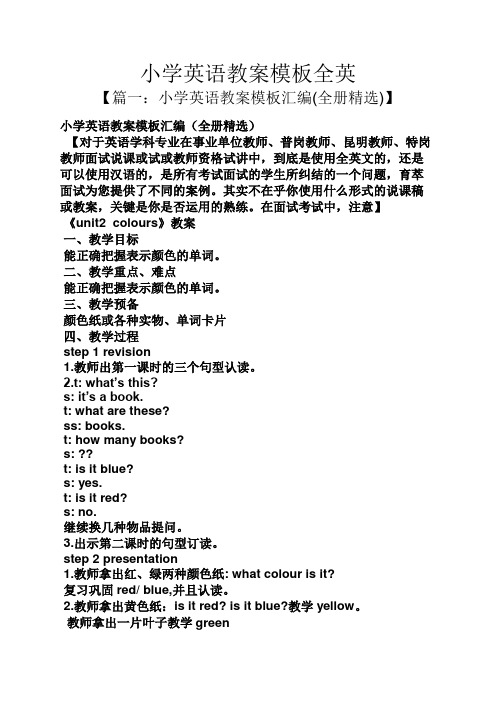
小学英语教案模板全英【篇一:小学英语教案模板汇编(全册精选)】小学英语教案模板汇编(全册精选)【对于英语学科专业在事业单位教师、普岗教师、昆明教师、特岗教师面试说课或试或教师资格试讲中,到底是使用全英文的,还是可以使用汉语的,是所有考试面试的学生所纠结的一个问题,育萃面试为您提供了不同的案例。
其实不在乎你使用什么形式的说课稿或教案,关键是你是否运用的熟练。
在面试考试中,注意】《unit2 colours》教案一、教学目标能正确把握表示颜色的单词。
二、教学重点、难点能正确把握表示颜色的单词。
三、教学预备颜色纸或各种实物、单词卡片四、教学过程step 1 revision1.教师出第一课时的三个句型认读。
2.t: what’s this?s: it’s a book.t: what are these?ss: books.t: how many books?s: ??t: is it blue?s: yes.t: is it red?s: no.继续换几种物品提问。
3.出示第二课时的句型订读。
step 2 presentation1.教师拿出红、绿两种颜色纸: what colour is it?复习巩固red/ blue,并且认读。
2.教师拿出黄色纸:is it red? is it blue?教学yellow。
教师拿出一片叶子教学green教师拿出一个自制的红绿灯教学一首小诗:red, red stop;yellow yellow wait;green green go go go!3. t show an orange: what’s this ? it’s an orange. what colour is it? it’s orange.t: orange is orange.4.show a peach:what colour is it? it’s pink.教学粉红色。
5. show a chocolate: what colour is it? it’s brown.教学棕色。
小学英语教案20篇英文版

小学英语教案20篇英文版小学英语教学是教育的基础,也是每一个孩子学习英语的开端。
为了帮助小学英语老师更好地开展教学工作,提高孩子的英语学习成绩,以下是20篇小学英语教案的英文版,供广大小学英语教师参考。
1. Title: Introducing MyselfContent: Students learn to introduce themselves in English.Objectives: By the end of the class, students should be able to introduce themselves inEnglish.Materials: PPT, pictures, handoutsProcedure:1. Warm-up: Greeting students and asking them about their names.2. Presentation: Using pictures to introduce oneself and providing examples.3. Practice: Students practice introducing themselves in pairs.4. Production: Students present themselves in front of the class.5. Evaluation: Checking students’ pronunciation and fluency.2. Title: ColorsContent: Students learn how to recognize and say different colors in English.Objectives: By the end of the class, students should be able to recognize and name different colors in English.Materials: PPT, flashcards, handoutsProcedure:1.Warm-up: Using colored flashcards to engage students.2. Presentation: Using PPT to show pictures of different colors and their names.3. Practice: Students match the colors with their names and practice saying them.4. Production: Students createtheir own pictures and describe them in English.5. Evaluation: Checking students’ ability to recognize and name different colors.3. Title: NumbersContent: Students learn how to recognize and say the numbers from 1 to 20 in English.Objectives: By the end of the class, students should be able to recognize and say the numbers from 1 to 20 in English.Materials: PPT, flashcards, handoutsProcedure:1. Warm-up: Using number flashcards to engage students.2. Presentation: Using PPT to show pictures of the numbers from 1 to 20 and their names.3. Practice: Students match the numbers with their names and practice saying them.4. Production: Students practice counting in English and count the number of objects in the classroom.5. Evaluation: Checking students’ ability to recognize and say the numbers from 1 to 20.4. Title: ShapesContent: Students learn how to recognize and name different shapes in English.Objectives: By the end of the class, students should be able to recognize and name different shapes in English.Materials: PPT, flashcards, handoutsProcedure:1. Warm-up: Using shape flashcards to engage students.2. Presentation: Using PPT to show pictures of different shapes and their names.3. Practice: Students match the shapes with their names and practice saying them.4. Production: Students create their own pictures using different shapes and describe them in English.5. Evaluation: Checki ng students’ ability to recognize and name different shapes.5. Title: FamilyContent: Students learn how to talk about their family members in English.Objectives: By the end of the class, students should be able to talk about their family members in English.Materials: PPT, flashcards, handoutsProcedure:1.Warm-up: Asking students about their family members.2. Presentation: Using PPT to show pictures of different family members and their names.3. Practice: Students practice talking about their family members in pairs.4. Production: Students present their family members in front of the class.5. Evaluation: Checking students’ ability to talk about their family members in English.6. Title: AnimalsContent: Students learn how to recognize and name different animals in English.Objectives: By the end of the class, students should be able to recognize and name different animals in English.Materials: PPT, flashcards, handoutsProcedure:1. Warm-up: Using animal flashcards to engage students.2. Presentation: Using PPT to show pictures of different animals and their names.3. Practice: Students match the animals with their names and practice saying them.4. Production: Students create their own pictures using different animals and describe them in English.5. Evaluation: Chec king students’ ability to recognize and name different animals.7. Title: WeatherContent: Students learn how to recognize and name different types of weather in English.Objectives: By the end of the class, students should be able to recognize and name different types of weather in English.Materials: PPT, flashcards,handoutsProcedure:1. Warm-up: Asking students about the weather outside.2. Presentation: Using PPT to show pictures of different types of weather and their names.3. Practice: Students practice recognizing and naming different types of weather.4. Production: Students describe the weather in a particular place.5. Evaluation: Checking students’ ability to recognize and name different types of weather.8. Title: Food and DrinksContent: Students learn how to recognize and name different types of food and drinks in English.Objectives: By the end of the class, students should be able to recognize and name different types of food and drinks in English.Materials: PPT, flashcards, handoutsProcedure:1.Warm-up: Asking students about their favorite food and drinks.2. Presentation: Using PPT to show pictures of different types of food and drinks and their names.3. Practice: Students practice recognizing and naming different types of food and drinks.4. Production: Students decide on a menu and describe the food and drinks in English.5. Evaluation: Checking students’ ability to recognize and name different types of food and drinks.9. Title: My BodyContent: Students learn how to recognize and name different parts of the body in English.Objectives: By the end of the class, students should be able to recognize and name different parts of the body in English.Materials: PPT, flashcards, handoutsProcedure:1. Warm-up: Asking students about different parts of the body.2. Presentation: Using PPT to show pictures of different parts of the body and their names.3. Practice: Studentspractice recognizing and naming different parts of the body.4. Production: Students draw a person and label the different parts of the body in Eng lish.5. Evaluation: Checking students’ ability to recognize and name different parts of the body.10. Title: JobsContent: Students learn how to recognize and name different types of jobs in English.Objectives: By the end of the class, students should be able to recognize and name different types of jobs in English.Materials: PPT, flashcards, handoutsProcedure:1. Warm-up: Asking students about their dream job.2. Presentation: Using PPT to show pictures of different types of jobs and their names.3. Practice: Students practice recognizing and naming different types of jobs.4. Production: Students choose a job and describe it in English.5. Evaluation: Checking students’ ability to recognize and name different types of jobs.11. Title: Days of the WeekContent: Students learn how to recognize and say the days of the week in English.Objectives: By the end of the class, students should be able to recognize and say the days of the week in English.Materials: PPT, flashcards, handoutsProcedure:1. Warm-up: Asking students about their favorite day of the week.2. Presentation: Using PPT to show pictures of the days of the week and their names.3. Practice: Students practice recognizing and saying the days of the week.4. Production: Students describe their schedule for the week.5. Evaluation: Checking students’ ability to recognize and say the days of the week.12. Title: Months of the YearContent: Students learn how to recognize and say the months of the year in English.Objectives: By the end of the class, students should be able to recognize and say the months of the year in English.Materials: PPT, flashcards, handoutsProcedure:1. Warm-up: Asking students about their favorite month of the year.2. Presentation: Using PPT to show pictures of the months of the year and their names.3. Practice: Students practice recognizing and saying the months of the year.4. Production: Students describe their favorite season and the months that belong to it.5. Evaluation: Checking students’ ability to recognize and say the months of the year.13. Title: TimeContent: Students learn how to tell the time in English.Objectives: By the end of the class, students should be able to tell the time in English.Materials: PPT, flashcards, handoutsProcedure:1. Warm-up: Asking students about their favorite time of the day.2. Presentation: Using PPT to show pictures of the clock and different times.3. Practice: Students practice telling the time in English.4. Production: Students plan their daily schedule and write it in English.5. Evaluation: Checking students’ ability to tell the time in English.14. Title: Weather ForecastContent: Students learn how to give a weather forecast in English.Objectives: By the end of the class, students should be able to give a weather forecast in English.Materials: PPT, flashcards, handoutsProcedure:1.Warm-up: Asking students about the weather outside.2. Presentation: Using PPT to show different weather conditions andvocabulary.3. Practice: Students practice giving a weather forecast in pairs.4. Production: Students give a weather forecast in front of the class.5. Evaluation: Checking students’ ability to give a weather forecast in English.15. Title: SeasonsContent: Students learn how to recognize and name the different seasons in English.Objectives: By the end of the class, students should be able to recognize and name the different seasons in English.Materials: PPT, flashcards, handoutsProcedure:1. Warm-up: Asking students about their favorite season.2. Presentation: Using PPT to show pictures of the different seasons and their names.3. Practice: Students practice recognizing and naming the different seasons.4. Production: Students write a paragraph about their favorite season in English.5. Evaluation: Checking students’ ability to recognize and name the different seasons in English.16. Title: ToysContent: Students learn how to recognize and name different types of toys in English.Objectives: By the end of the class, students should be able to recognize and name different types of toys in English.Materials: PPT, flashcards, handoutsProcedure:1. Warm-up: Asking students about their favorite toy.2. Presentation: Using PPT to show pictures of different types of toys and their names.3. Practice: Students practice recognizing and naming different types of toys.4. Production: Students describe their favorite toy in English.5. Evaluation: Checking students’ ability to recognize and name different types of toys.17. Title: School SuppliesContent: Students learn how to recognize and name different school supplies in English.Objectives: By the end of the class, students should be able to recognize and name different school supplies in English.Materials: PPT, flashcards, handoutsProcedure:1. Warm-up: Asking students about their favorite school supply.2. Presentation: Using PPT to show pictures of different school supplies and their names.3. Practice: Students practice recognizing and naming different school supplies.4. Production: Students describe the contents of their school bag in English.5. Evaluation: Checking students’ ability to recognize and name different school supplies.18. Title: Parts of a HouseContent: Students learn how to recognize and name different parts of a house inEnglish.Objectives: By the end of the class, students should be able to recognize and name different parts of a house in English.Materials: PPT, flashcards, handoutsProcedure:1.Warm-up: Asking students about the different rooms in their house.2. Presentation: Using PPT to show pictures of different parts of a house and their names.3. Practice: Students practice recognizing and naming different parts of a house.4. Production: Students describe their favorite room in their house in English.5. Evaluation: Checking students’ ability to recognize and name different parts of a house.19. Title: HolidaysContent: Students learn how to recognize and name different holidays in English.Objectives: By the end of the class, students should be able to recognize and name differentholidays in English.Materials: PPT, flashcards, handoutsProcedure:1. Warm-up: Asking students about their favorite holiday.2. Presentation: Using PPT to show pictures of different holidays and their names.3. Practice: Students practice recognizing and naming different holidays.4. Production: Students write about their favorite holiday in English.5. Evaluation: Checking students’ ability to recognize and name different holidays in English.20. Title: SportsContent: Students learn how to recognize and name different sports in English.Objectives: By the end of the class, students should be able to recognize and name different sports in English.Materials: PPT, flashcards, handoutsProcedure:1. Warm-up: Asking students about their favorite sport.2. Presentation: Using PPT to show pictures of different sports and their names.3. Practice: Students practice recognizing and naming different sports.4. Production: Students describe their favorite sport in English.5. Evaluation: Checking students’ ability to recognize and name different sports in English.以上是20篇小学英语教案的英文版,它们覆盖了小学英语教学的各个方面。
小学英语全英教案(17篇)
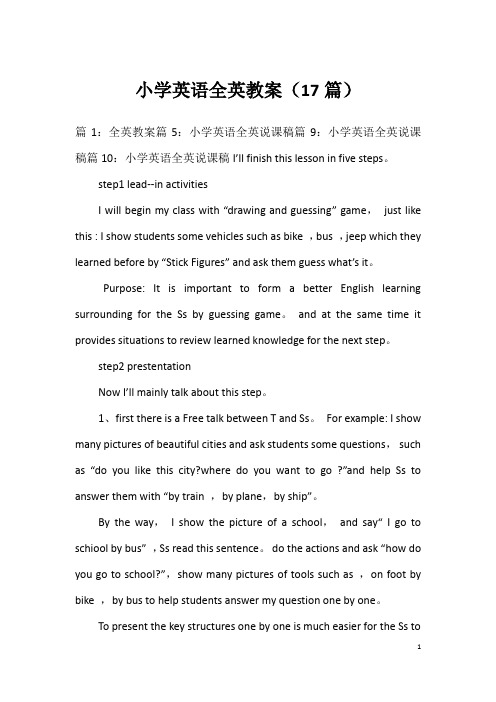
小学英语全英教案(17篇)篇1:全英教案篇5:小学英语全英说课稿篇9:小学英语全英说课稿篇10:小学英语全英说课稿I’ll finish this lesson in five steps。
step1 lead--in activitiesI will begin my class with “drawing and guessing” game,just like this : I show students some vehicles such as bike ,bus ,jeep which they learned before by “Stick Figures” and ask them guess what’s it。
Purpose: It is important to form a better English learning surrounding for the Ss by guessing game。
and at the same time it provides situations to review learned knowledge for the next step。
step2 prestentationNow I’ll mainly talk about this step。
1、first there is a Free talk between T and Ss。
For example: I show many pictures of beautiful cities and ask students some questions,such as “do you like this city?where do you want to go ?”and help Ss to answer them with “by train ,by plane,by ship”。
小学英语教学目标全英教案模板(共3篇)
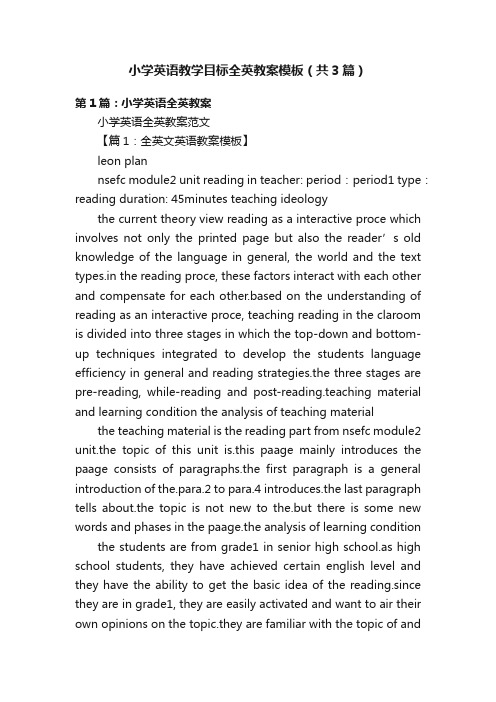
小学英语教学目标全英教案模板(共3篇)第1篇:小学英语全英教案小学英语全英教案范文【篇1:全英文英语教案模板】leon plannsefc module2 unit reading in teacher: period:period1 type:reading duration: 45minutes teaching ideologythe current theory view reading as a interactive proce which involves not only the printed page but also the reader’s old knowledge of the language in general, the world and the text types.in the reading proce, these factors interact with each other and compensate for each other.based on the understanding of reading as an interactive proce, teaching reading in the claroom is divided into three stages in which the top-down and bottom-up techniques integrated to develop the students language efficiency in general and reading strategies.the three stages are pre-reading, while-reading and post-reading.teaching material and learning condition the analysis of teaching material the teaching material is the reading part from nsefc module2 unit.the topic of this unit is.this paage mainly introduces the paage consists of paragraphs.the first paragraph is a general introduction of the.para.2 to para.4 introduces.the last paragraph tells about.the topic is not new to the.but there is some new words and phases in the paage.the analysis of learning condition the students are from grade1 in senior high school.as high school students, they have achieved certain english level and they have the ability to get the basic idea of the reading.since they are in grade1, they are easily activated and want to air their own opinions on the topic.they are familiar with the topic of andknow some.but they may not know before.moreover, their vocabulary is limited so they may have difficulties in understanding some sentences.learning objectives nguage skills ? at the beginning of the cla, can predict the content of the paage based on the title.? can scan the paage and find out the specific information such as the person related withcan summarize the paage with the help of the clues of the nguage knowledgecan master the key words and phrases of the paage as follows,.? can learn , especially 3.affectswill realize that and they will concern themselves with the iue of4.cultural awarenewill broaden their minds by knowing something about 5.learning strategieswill cultivate their ability individual learning and cooperative learning by doing someactivities independently and some in groups.? will communicate with each other in english while doing the group nguage difficultiesfocuses and anticipated language focusesthis is a reading period so the focus is to cultivate the students’ reading skills.the many activities are designed to help to train their reading skills, such as predicting, skimming, scanning and summarizing.it is also important for the to master the new words and phrases.anticipated difficultiesas the have a limited vocabulary, so they may have some difficulties in understanding the paage.so the teacher will help them learn the new words and phrases.may did not heard before, so the teacher will tell them some background knowledge aboutit.teaching methodthree-stage model: based on the understanding of reading as an interactive proce, teaching reading in the claroom is divided into three stages in which the top-down and bottom-up techniques integrated to develop the students language efficiency in general and reading strategies.the three stages are pre-reading, while-reading and post-reading.teaching aids multimedia devices and ppt documents: in order to help to fully understand the whole paage, i adopt multimedia devices and ppt documents to bring the real-life situation into the claroom.teaching procedures step1.lead-in(6min)activity1.greetings and free-talking(2min)t leads into the topic by asking some they know.tell the name of the they know freely.t: hello boys and girls.(say hello to the teacher.)t: when we say , what appears in your minds?(tell the things appear in their minds freely.)t: what are the ?(tell some names of.) activity2.picture-talking(4min)t shows some pictures about the in china and abroad.after seeing the pictures, are expected to tell the similarities of them.t: just now, you talk about some in china.now, let’s see some pictures of some.(t shows the pictures and see them carefully.) t: what do the have in common?for example, they are very precious.what are your opinions?(t gives them some hints and tell the characteristics of)[aims] in this step, t first leads in the topic by talking with the freely about the whichis familiar to them and then see some pictures and tell the characteristics.these two activities aim to arouse the ’ interests in the topic and activate their old knowledge of.then will bementally prepared for the reading comprehension.what’s more,when they are talking about the charateristics of, they will realize that theare rare and precious and they will concern themselves with the iue of.step2.pre-reading(3min)activity1.knowing something about(1min)t gives a brief introduction of the.will know the t: today, we are going to learn.it is.do you know what is?(t shows some pictures ofand get to know the.)activity2.predicting(2min)t asks to read the title of the paage and then ask them some questions.will predict the content of the paage with the help of the title.t: please look at the ti tle “”, what does “” mean?(if the can not give the answer, then t explain it.)t: in search means that people are looking for it.why are people looking for it? can you gue? what will the paage talk about?(predict the content, but t will not give the answer here.)[aims] in this step, the first know some information of the;the background information will make it easier for the to understand the paage.then t asks to make predictions about the paage.it aims to help develop the reading skills of predicting.step3.while-reading(22min)activity1.skimming(4min)skim the whole paage and find out and check their predictions.t: why are people still ? here is a multiple choice for you.activity2.scanning(3min)t presents several true or false statements and asks the to scan the paage and judge the right from the wrong.(keys: F,F,T,T,F)activity3 close-reading(15min)t designs various kinds of activities and do the activities to fully understand the paage.para.1t: please read para.1 carefully and then take some note aboutthe.para.2-4please read para.2-4 carefully and then find out the removal of the room.please read para.2-4 carefully and then find out the person related with the amber room and the things them down with it.para.5 please read para.5 carefully and then find out the the rebuilding of the amber room.【篇2:pep小学英语全英教案模板】the english teaching plan of pep book 4enhe primary school teacher:___________ the curriculum schedule cla:____________ cla:____________ the teaching schedule the students’ result tablethe english curriculum standard英语课程标准一级目标总体目标:对英语有好奇心,喜欢听他人说英语;能根据教师的简单指令做游戏、做动作、做事情(如涂颜色、连线);能做简单的角色扮演;能唱简单的英文歌曲,说简单的英语歌谣;能在图片的帮助下听懂和读懂简单的小故事;能交流简单的个人信息,表达简单的情感和感觉;能书写字母和单词;对英语学习中接触的外国文化习俗感兴趣。
小学英语教案(集锦15篇)

小学英语教案(集锦15篇)小学英语教案1教材分析本节课是学生学习现在进行时的第一课时,要求能够听、说、读、写五个动词短ing 的形式。
能运用句型“What are you doing? I’m doing the dishes/….”询问别人正在做什么并作答。
do the dishes, cook dinner, read a book,都属于上册学过的四会内容,对学生来说比较简单,drawing pictures, answering the phone相对有些难度。
针对这种情况,我采用由易到难、由旧词组练习新句型的教学策略来降低学生理解及表达的难度。
另外,我创设了一系列具体而典型的生活情景,让学生亲身体验现在进行时的用法,如洗碗、读书、在黑板上画画、接电话等等,在此过程中,我还充分调动学生运用肢体语言,帮助学生理解领会现在进行时的功能。
学情分析农村的小孩接触英语的机会比较少,大部分学生对英语不是很感兴趣,所以要根据他们的特点来改革课堂教学模式,让孩子在乐中学,在玩中学,通过表演,竞赛等形式来激发他们的学习兴趣。
在这堂课中通过游戏Who is faster? Let’s guess.小组编对话等形式,情景真实,可操作性强,学生参与面广,实行以老师为主导,以学生为主体,以训练为主线的三为主的教学思想和民主教学思想。
教学目标Aim 1.能够听、说、读、写动词短语的ing形式:drawing pictures, doing the dishes, cooking dinner, reading a book, answering the phone 。
Aim 2.能运用句型“What are you doing? I’m doing the dishes/….”询问别人正在做什么并作答。
Aim 3.通过说唱Let’s chant部分的歌谣巩固复习Let’s learn部分的动词短语和句子。
教学重点和难点本课时需要掌握五个动词短语的ing形式,能够理解下一课时的主要句型“What are you doing?”并能用“I am doing the dishes/…”作答。
小学英语教案全英模板

小学英语教案全英模板【篇一:英语教案全英模板】pep六年级英语unit 1 how do you go there?period oneteaching contents: part a let,s learn &a mp; let,s playteaching aims:1.to enable the students to master the four skills phrases: on foot, by bike, bybus, by train, by plane, by ship, by subway2.to enable the students to ask about the ways of traffic with the followingsentence patterns: how do you go to school? or how do you go to canada…?Hand answer with—i go by…II teaching focus:to master the four skills phrases: by train, by plane, by subway, by ship, by bike,on footteaching difficulty:to differ —subwayH from—trainllteaching methods: communicative approach teaching aids:1.word cards2.tape recorder and tape3. multi-media player teaching procedure:1.(warm-up)greeting: good morning , class ! glad to meet you again. how are you? what day is it? what ?s the date? what's the weather like today?2.presentation show a picture of bus t: what’s this? s: it‘s a bus.t: i go to school by bus. how do you go to school?(show a picture of bike and help a student to answer with --i go to school by bike.H)(in the same ways)teach —by subwayll and —by trainll —by shipll —by planell —on footll)subway: its an underground railway in a city, it travels very fast, we can see subway in hong kong, beijing, shanghai, gongzhou… explain the differences between subway and train pay attention to the pre. — byll —onl3.play gamesask one s to the front and stick the word cards next to the phrases written on the bb when t read the new phrases quickly and the other ss put up their cards. the one who reflect fastest and correctly is the winner.4.listen to the tape of part a let’s learn and follow it.pay attention to the tone and pronunciation5.practice: let’s playt offer many places (the usa. england australia hong kong shanghai guangzhou the moon…)and traffic ways (by car/ taxi/ bus・・・ on foot) ss practice with above places and ways in pairs: a: how do you go to school?b: i go to school on foot .encourage the ss to make up as many sentences as they can.6.spelling competitiondivide the class into tow groups. show the pictures of traffic tools and ask ss to spell the phrases. the first one who puts up hand gets the chance to spell. the group spell out more phrases are the winners.homeworkcopy the new words and phrases finish page1 of the abbb design:unit onehow do you go there?how do you go to school/ canada?i go to school on foot/ by subway/ bus/ train/ taxi・・・【篇二:pep英语全英教案模板】(此文档为word格式,下载后您可任意编辑修改!)the english teaching planof pep book 4enhe primary school teacher:the curriculum scheduleclass: _____________________class: _____________________the teaching schedule the students, result table【篇三:史上最好的小学英语全英文说课稿模板】小学英语全英文说课稿模板background of english teaching in primary school: it is not a long history that english is as asubject in primary school in our country and the main instructional aims of teaching english inprimary school is to cultivate pupils, basic abilities of their listening and speaking and their goodsense of the english language. our boys and girls are exposed to english for the first time, so it isvery important to develop their keen interest in english.i.contents:today i,m going to talk about part b of unit 2, pep primaryenglish, book 3. this lessonincludes two parts: let,s talk and let,s practice. in section 1, it mainly deals with the dialogueabout "what,s in the schoolbag?” and the answers. and insection 2, it provides a real situation forthe ss to prastise the pattern: how many +n.(pl.)+ do you have?and the answer: i have 23 +n.(pl.)ii.teaching aims1.aims on the knowledge(1)to enable the ss to understand and speak: "my schoolbagis heavy. what,s in it? thank you somuch.” make sure that ss can use these sentences in real situations.(2)to help ss to finish the survey.(3)let ss finish the assessme nt of "let's check” in this unit.2.aims on the abilities(1)to develop ss, abilities of l istening and speaking.(2)to train the ss9 ability of working in groups.(3)to foster ss, abilities of communication and their innovation.3.aims on the emotion(1)to foster ss' consciousness of good co-operation and proper competition.(2) to lead ss to show their loveliness to the poor.iii.key-points of this lesson(1)to help ss ask and answer the question: what,s in it?(2)to enable ss to study in groups and co-operate skillfully.(3)to develop ss, interest in english.iv.difficult points(1)to help the ss ask and answer the question “what’s in it?” and make sure they can use the plural nouns correctly.(2)to finish the survey by themselves.v.teaching methodsas we all know: the main instructional aims of learning english in primary school is to cultivate pupils, basic abilities of listening and speaking and their good sense of the english language. so in this lesson i,ll mainly use “task-based” teaching method. that is to say, i will let the ss learn inreal situations, finish a task by making a survey to help the ss to get a better understanding of thekey structure of the dialogue. i will arrange four kinds of activities: singing, guessing game, finishing a survey and having a competition. and in this lesson a recorder, cai, school things and a printed form will be needed. students should prepare some school things.vi.teaching procedures and purposes of my designing.i,ll finish this lesson in five steps.step 1. warm-up and preview1.free talk between t and ss about things in the classroom.2.sing the song together: books and pencils.3.do some tpr, for example: show me your english book. show me your crayon.4.review the numbers by asking: “how many crayons do you have?”purpose: it is important to form a better english learning surrounding for the ss by singing anddoing some total physical response and at the same time it provides situations to review learnedknowledge for the next step.step 2. presentationnow i’ll mainly talk about this st ep.1.present the pattern: “my schoolbag is heavy.” “what’s in it?.”(1)show a bag and say: “look! i have a bag.” carry it and say: “oh, it is heavy. my schoolbag isheavy.” help the ss understand the meaning with the help of my body language. then lead the ssto read the sentence. make sure they can say it correctly.(2)t: my schoolbag is heavy.open the bag and say: “what’s in it? what,s in my schoolbag?” take out a chinese book. then do the action again. let the ss read the sentence.2.play a guessing game. divide the whole class into four groups to have acompetition.let them guess: what,s in the bag? how many? purpose: to present the key structures one by oneis much easier for the ss to learn and grasp the meanings. proper competition can arouse the ss’ interes t in english learning.3.with the help of the cai to present the dialogue. set a situation to help ss understand: twoss are coming. one girl is carrying a heavy bag on her back. they are talking.girl: my schoolbag is heavy.boy: what’s in it?girl: 20 story-books, 32 pencil, 9 rulers, 12 crayons and 30 picture-books. etc.boy: what will you do?girl: they are for the poor.boy: great! i’ll bring some school things too.the boy comes back home and puts a lot of things into the bag. then he goes to school again andgives them to a teacher. while he is taking them out, he is counting the numbers of all things. the teacher says: thank you soooooooo much.4.mention that we should take care of the poor.5.play the cassette. let the ss listen and imitate the dialogue. pay attention to their pronunciation and intonation.purpose: cai can provide a real situation for the ss to understand the dialogue and therelationships between people better. tell the ss we should show our loveliness to the ss.step 3. practicedivide ss into groups of six children. each one would finishthe printed form by asking andanswering: how many storybooks do you have? find outwhich group finishes faster. story bookspicture-books sharpeners crayons pencils erasers pencilcases rulers chen jie 8 24 3 32 26 4 1 3purpose: task-based teaching method is used here to develop ss' ability of communication andalso their ability of co-operation will be well trained.step 4. assessmenthelp ss finish “let’s check” of this unit and workbook.purpose: to check the knowledge ss have learned in this period.step 5. add-activity1.let ss tell each other how many school things they have after class. tell their parents how many school things they have at home.2.take care of everything they have.purpose: revision is so important that ss should speak english as much as they as in class orafter class. it is necessary for the ss to do some extensive exercises after class to consolidate the knowledge they learned.小学英语说课稿(英文万能版)•good morning, my dear judges. i am, from. i,m glad to interpret my teaching design here.•the teaching content is part of pep primary english, book . this unit is mainly about now, i will explain the lesson from the following aspects. 1.教学内容(体现教材的整合)firstly, let,s focus on the analysis of teaching content.the lesson is a new one of unit it includes and these key words,2.教学对象(根据不同年级的学生,描述其特点)secondly, it is about the students.our students are in gradethey are active and curious, interested in new things.after learning english for years, they have some basic english background knowledge, so theteacher should attach importance to the communication with them, providing them the chances ofusing language.they have learnt english for years, and have already known it is not difficult for them to understand and use the language3.教学目标(根据具体内容定目标和要求)so, i set the following aims.by the end of the lesson, students will be able to read, recognize, and use these words:and, these sentences: by the end of the lesson, ss can understand theand get useful information from the through attentive listening / reading.ss are able to talk about ss can useto give suggestions on ss’ abilities of listening and speaking will be developed.(affect;learning strategies;cultural awareness.)in this lesson, the emotional aim isto help students cultivate and foster their abilities of working in groups.to foster ss’ consciousness of good-cooperation and proper competition.to help ss cultivate their abilities to analyze and solve problems independently.to foster ss’ initiative and creativeness.。
小学英语教案万能模板【优秀10篇】

小学英语教案万能模板【优秀10篇】新标准小学英语第四册Module1 Unit1教案篇一module1 unit 1教学目标:1、掌握以下单词的读写,并能熟练使用:nice,a bit,shy,clever,naughty,2、熟练使用句子:this is . he/she is very +adj.3、会用所学的形容词语描述自己、家人和朋友。
教学重难点:1、单词的读音、拼写和运用。
2、形容词在句子中的正确使用。
教学过程:一、greetings.二、duty report.三、warming-up and reviewing.1、sing songs.2、ask and answer.如:t: thin. s: fat.复习(fat,thin,old, young,tall,short,bit,little/small)3. (出示图片)t:this is my friend ms smart. she’s a nice teacher. she’s tall and thin. à 引出课题module 1 friends unit 1 she’s a nice teacher.四:presentation1、呈现新单词:t: look, this is my family. this is my father, he is very nice. this is my mother, she is nice too, but she is a bit shy. this is my little sister, she is thin and very clever. this is my cousin, he is very naughty . we’re happy in the spring festival. (教师把绘制的“全家福”图画贴在黑板上。
)(教读新单词)nice.强调“i”的发音。
小学英语教案模板五篇
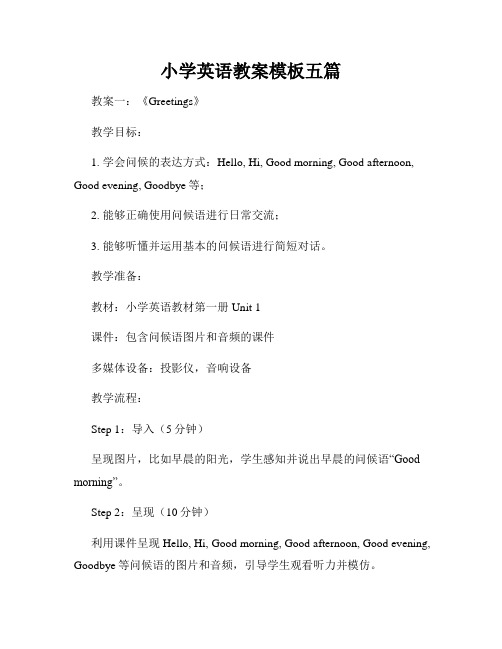
小学英语教案模板五篇教案一:《Greetings》教学目标:1. 学会问候的表达方式:Hello, Hi, Good morning, Good afternoon, Good evening, Goodbye等;2. 能够正确使用问候语进行日常交流;3. 能够听懂并运用基本的问候语进行简短对话。
教学准备:教材:小学英语教材第一册Unit 1课件:包含问候语图片和音频的课件多媒体设备:投影仪,音响设备教学流程:Step 1:导入(5分钟)呈现图片,比如早晨的阳光,学生感知并说出早晨的问候语“Good morning”。
Step 2:呈现(10分钟)利用课件呈现Hello, Hi, Good morning, Good afternoon, Good evening, Goodbye等问候语的图片和音频,引导学生观看听力并模仿。
Step 3:口语练习(15分钟)分组进行对话练习,每组两人进行问候对话练习,老师巡回指导。
Step 4:巩固训练(15分钟)学生自由搭配问候语进行对话,老师辅助纠正。
Step 5:语音训练(10分钟)利用课件中的音频进行语音训练,要求学生模仿正确发音。
Step 6:小结(5分钟)回顾今天学习的内容,总结所学的问候语,并展示学生的听说练习成果。
教案二:《Numbers 1-10》教学目标:1. 学会数字1-10的发音和书写;2. 能够听懂并正确使用数字进行简单的交流;3. 能够通过游戏等活动巩固数字1-10的学习。
教学准备:教材:小学英语教材第一册Unit 2课件:数字1-10的图片和音频游戏道具:数字卡片教学流程:Step 1:导入(5分钟)利用课件呈现数字1-10的图片和音频,引导学生观看听力并模仿。
Step 2:识字练习(10分钟)学生观看课件,边看边说,并尝试自己写下每个数字。
Step 3:听力训练(15分钟)利用课件中的音频进行听力训练,要求学生听并用数字卡片拼出正确的数字。
小学英语教案模板5篇

小学英语教案模板5篇学校英语教案模板篇1教学内容:Part B and D of Unit 11 A boy and a girl, Fun with English.教学目标:1、 Enable the Ss to understand, read and say the new words “boy, girl, Chinese, thin, fat, tall, short.”2、 Enable the Ss to use the sentence in their daily life.3、Develop the Ss' abilities of listening, speaking, and writing English.4、 Train the Ss' abilities of cooperation.重点难点:1、 The pronunciation of some new words “girl, thin, tall, small”2、 Enable the Ss to say and use the sentences“My name is …I'm …”to introduce themselves to others.教学预备:CAI、tape、recorder.教学方法:Communicational Approach教学过程:Step1、 Warm—up1、 Sing a song “Hello”。
2、 Free talkT: This is … Her name is Helen.What's your name? Nice to meet you.Step2、 Presentation & practice1、 Present and practice the new sentence “My name is …”2 T: Do you want to know my name?Ss: …T: My name is …(T presents the new sentence “My name is …”)T: My name is Zhu Xiaoyan. How about your name?S: My name is ……2、 Present and practice the new words “boy, girl, Chinese, I'm from…”T: (Show the Ss the picture of Liu Tao) Look, this is …Ss: Liu Tao. T: This is Liu Tao. So we know his name is Liu Tao.T: How about his sex?T: What's this?T: This is a Chinese flag. (Present and teach the word “boy, Chinese”)T: (point to one of them) this is a … Liu Tao is a Chinese boy.How about...? T: (point to one of them)… is a …T: Who's she? (Present the new word “girl”)T: Miss Zhu is a girl. I'm a Chinese girl. And I'm from Rudong.T: Where are you from? …(Present the sentence “I'm from…”)Do you know where is Liu Tao from?3、Present and practice the new words “fat, thin, tall, short”T: We know Liu Tao is from Shanghai. Shanghai is a beautiful city. Let's go to Shanghai.Ss: OK. T: Where is it?Ss: It's a zoo.T: Let's see what are in the zoo. (Present some pictures of animals)T: Look, this is a …(monkey) And this is a monkey. (Present and practice the word “fat, thin”)T: (Present the picture of LiuTao and Yao Ming) This is .T: Yao Ming is . (Present and practice the new word “tall, short”)4、 Present and read the textT: Now, how much do you know about Liu Tao? Say it out! …T: Let's read and learn Liu Tao's self-introduction.(Ask the Ss to read after the tape )T: Close your books, please. Look , This is Liu Tao's self-introduction, and this is me, can you help me correct it? (Ask the Ss to correct the self-introduction, and learn the example.)Step3、ConsolidationT: Now, boys and girls.Try to introduce yourselves.You have 30 seconds to do it.Step4、 Homework1、 Make your self-introduction card.2、 Introduce yourselves to five people and ask them to sign on the back of your introduction cards.板书设计:Unit 11 A boy and a girlMy name is … I'm aChinese… boy girl I'm from…I'm …(年龄) tall shortI'm …(特征) fat thin学校英语教案模板篇2一、教学内容1.词汇(略)。
小学英语优秀教案模板5篇
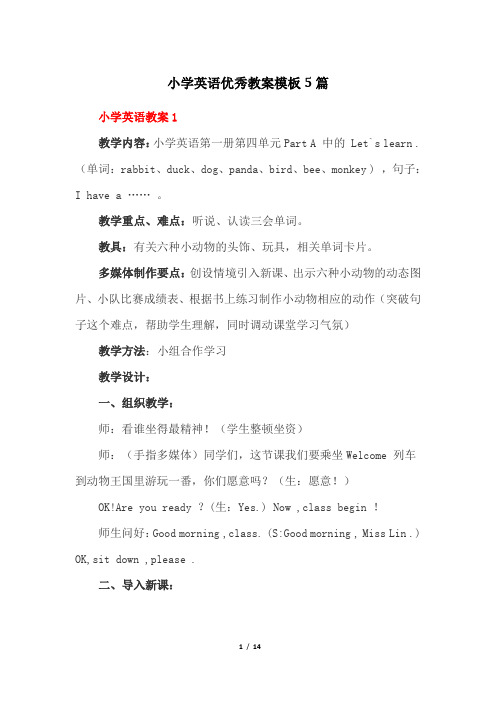
小学英语优秀教案模板5篇小学英语教案1教学内容:小学英语第一册第四单元Part A 中的 Let`s learn .(单词:rabbit、duck、dog、panda、bird、bee、monkey ) ,句子:I have a ……。
教学重点、难点:听说、认读三会单词。
教具:有关六种小动物的头饰、玩具,相关单词卡片。
多媒体制作要点:创设情境引入新课、出示六种小动物的动态图片、小队比赛成绩表、根据书上练习制作小动物相应的动作(突破句子这个难点,帮助学生理解,同时调动课堂学习气氛)教学方法:小组合作学习教学设计:一、组织教学:师:看谁坐得最精神!(学生整顿坐资)师:(手指多媒体)同学们,这节课我们要乘坐Welcome 列车到动物王国里游玩一番,你们愿意吗?(生:愿意!)OK!Are you ready ?(生:Yes.) Now ,class begin !师生问好:Good morning ,class. (S:Good morning , Miss Lin .) OK,sit down ,please .二、导入新课:师:(多媒体展示)同学们看,动物王国的小动物可真淘气,有的露出一只小耳朵,有的露出了一只半截小尾巴,还有的露出了一只小手。
那么你们能猜出它们是谁吗?(学生纷纷举手发言)——猜,是小学生的一大嗜好。
一石激起千层浪,学生的热情被点燃。
师:那让我们来看个究竟吧!(多媒体展示各种小动物的动态图片)——生动有趣的动画效果,激起学生的学习兴趣师:第一个出场的是谁……(在多媒体展示的过程中,学生说出各种小动物,老师借此板贴单词卡片)——结合个别学生课外参加补习班的情况,而这一课的单词又比较常见,很多同学能直接说出这些小动物用英语怎么说。
因此,借此导课。
三、教学单词:1、了解学生知识水平①、师:刚才老师听到有些同学知道这些小动物用英语怎么说,老师可真佩服你。
那么,你能站起来再说一遍吗?——及时鼓励!能说几个就说几个!——让每个学生知道自己很棒,感受成功的喜悦!(生说单词。
小学英语教案全英文版【三篇】
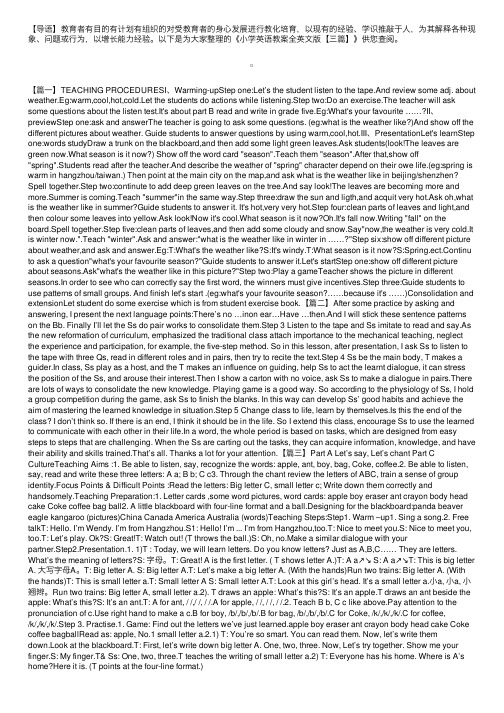
【导语】教育者有⽬的有计划有组织的对受教育者的⾝⼼发展进⾏教化培育,以现有的经验、学识推敲于⼈,为其解释各种现象、问题或⾏为,以增长能⼒经验。
以下是为⼤家整理的《⼩学英语教案全英⽂版【三篇】》供您查阅。
【篇⼀】TEACHING PROCEDURESI、Warming-upStep one:Let’s the student listen to the tape.And review some adj. about weather.Eg:warm,cool,hot,cold.Let the students do actions while listening.Step two:Do an exercise.The teacher will ask some questions about the listen test.It's about part B read and write in grade five.Eg:What's your favourite (II)previewStep one:ask and answerThe teacher is going to ask some questions. (eg:what is the weather like?)And show off the different pictures about weather. Guide students to answer questions by using warm,cool,hot.III、PresentationLet's learnStep one:words studyDraw a trunk on the blackboard,and then add some light green leaves.Ask students(look!The leaves are green now.What season is it now?) Show off the word card "season".Teach them "season".After that,show off "spring".Students read after the teacher.And describe the weather of "spring" character depend on their owe life.(eg:spring is warm in hangzhou/taiwan.) Then point at the main city on the map,and ask what is the weather like in beijing/shenzhen? Spell together.Step two:continute to add deep green leaves on the tree.And say look!The leaves are becoming more and more.Summer is coming.Teach "summer"in the same way.Step three:draw the sun and ligth,and acquit very hot.Ask oh,what is the weather like in summer?Guide students to answer it. It's hot,very very hot.Step four:clean parts of leaves and light,and then colour some leaves into yellow.Ask look!Now it's cool.What season is it now?Oh.It's fall now.Writing "fall" on the board.Spell together.Step five:clean parts of leaves,and then add some cloudy and snow.Say"now,the weather is very cold.It is winter now.".Teach "winter".Ask and answer:"what is the weather like in winter in ……?"Step six:show off different picture about weather,and ask and answer.Eg:T:What's the weather like?S:It's windy.T:What season is it now?S:Spring.ect.Continu to ask a question"what's your favourite season?"Guide students to answer it.Let's startStep one:show off different picture about seasons.Ask"what's the weather like in this picture?"Step two:Play a gameTeacher shows the picture in different seasons.In order to see who can correctly say the first word, the winners must give incentives.Step three:Guide students to use patterns of small groups. And finish let's start .(eg:what's your favourite season?……because it's ……)Consolidation and extensionLet student do some exercise which is from student exercise book.【篇⼆】After some practice by asking and answering, I present the next language points:There’s no …inon ear…Have …then.And I will stick these sentence patterns on the Bb. Finally I’ll let the Ss do pair works to consolidate them.Step 3 Listen to the tape and Ss imitate to read and say.As the new reformation of curriculum, emphasized the traditional class attach importance to the mechanical teaching, neglect the experience and participation, for example, the five-step method. So in this lesson, after presentation, I ask Ss to listen to the tape with three Qs, read in different roles and in pairs, then try to recite the text.Step 4 Ss be the main body, T makes a guider.In class, Ss play as a host, and the T makes an influence on guiding, help Ss to act the learnt dialogue, it can stress the position of the Ss, and arouse their interest.Then I show a carton with no voice, ask Ss to make a dialogue in pairs.There are lots of ways to consolidate the new knowledge. Playing game is a good way. So according to the physiology of Ss, I hold a group competition during the game, ask Ss to finish the blanks. In this way can develop Ss’ good habits and achieve the aim of mastering the learned knowledge in situation.Step 5 Change class to life, learn by themselves.Is this the end of the class? I don’t think so. If there is an end, I think it should be in the life. So I extend this class, encourage Ss to use the learned to communicate with each other in their life.In a word, the whole period is based on tasks, which are designed from easy steps to steps that are challenging. When the Ss are carting out the tasks, they can acquire information, knowledge, and have their ability and skills trained.That’s all. Thanks a lot for your attention.【篇三】Part A Let’s say, Let’s chant Part C CultureTeaching Aims :1. Be able to listen, say, recognize the words: apple, ant, boy, bag, Coke, coffee.2. Be able to listen, say, read and write these three letters: A a; B b; C c3. Through the chant review the letters of ABC, train a sense of group identity.Focus Points & Difficult Points :Read the letters: Big letter C, small letter c; Write down them correctly and handsomely.Teaching Preparation:1. Letter cards ,some word pictures, word cards: apple boy eraser ant crayon body head cake Coke coffee bag ball2. A little blackboard with four-line format and a ball.Designing for the blackboard:panda beaver eagle kangaroo (pictures)China Canada America Australia (words)Teaching Steps:Step1. Warm –up1. Sing a song.2. Free talkT: Hello. I’m Wendy. I’m from Hangzhou.S1: Hello! I’m ... I’m from Hangzhou,too.T: Nice to meet you.S: Nice to meet you, too.T: Let’s play. Ok?S: Great!T: Watch out! (T throws the ball.)S: Oh, no.Make a similar dialogue with yourpartner.Step2.Presentation.1. 1)T : Today, we will learn letters. Do you know letters? Just as A,B,C…… They are letters. What’s the meaning of letters?S: 字母。
小学英语教案全英文版(优秀13篇)
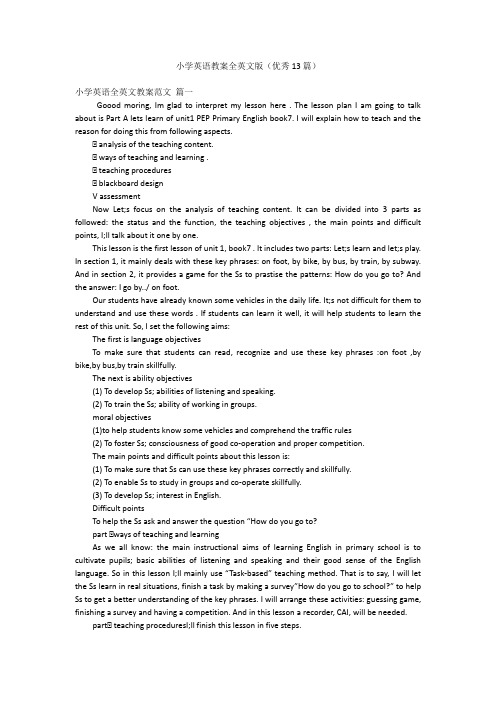
小学英语教案全英文版(优秀13篇)小学英语全英文教案范文篇一Goood moring, Im glad to interpret my lesson here . The lesson plan I am going to talk about is Part A lets learn of unit1 PEP Primary English book7. I will explain how to teach and the reason for doing this from following aspects.Ⅰ analysis of the teaching content.Ⅰ ways of teaching and learning .Ⅰ teaching proceduresⅠ blackboard designV assessmentNow Let;s focus on the analysis of teaching content. It can be divided into 3 parts as followed: the status and the function, the teaching objectives , the main points and difficult points, I;ll talk about it one by one.This lesson is the first lesson of unit 1, book7 . It includes two parts: Let;s learn and let;s play. In section 1, it mainly deals with these key phrases: on foot, by bike, by bus, by train, by subway. And in section 2, it provides a game for the Ss to prastise the patterns: How do you go to? And the answer: I go by../ on foot.Our students have already known some vehicles in the daily life. It;s not difficult for them to understand and use these words . If students can learn it well, it will help students to learn the rest of this unit. So, I set the following aims:The first is language objectivesTo make sure that students can read, recognize and use these key phrases :on foot ,by bike,by bus,by train skillfully.The next is ability objectives(1) To develop Ss; abilities of listening and speaking.(2) To train the Ss; ability of working in groups.moral objectives(1)to help students know some vehicles and comprehend the traffic rules(2) To foster Ss; consciousness of good co-operation and proper competition.The main points and difficult points about this lesson is:(1) To make sure that Ss can use these key phrases correctly and skillfully.(2) To enable Ss to study in groups and co-operate skillfully.(3) To develop Ss; interest in English.Difficult pointsTo help the Ss ask and answer the question “How do you go to?part Ⅰways of teaching and learningAs we all know: the main instructional aims of learning English in primary school is to cultivate pupils; basic abilities of listening and speaking and their good sense of the English language. So in this lesson I;ll mainly use “Task-based” teaching method. That is to say, I will let the Ss learn in real situations, finish a task by making a survey”How do you go to school?” to help Ss to get a better understanding of the key phrases. I will arrange these activities: guessing game, finishing a survey and having a competition. And in this lesson a recorder, CAI, will be needed.partⅠ teaching proceduresI;ll finish this lesson in five steps.step1 lead--in activitiesI will begin my class with drawing and guessing game, just like this : I show students some vehicles such as bike ,bus ,jeep which they learned before by Stick Figures and ask them guess what;s it.Purpose: It is important to form a better English learning surrounding for the Ss by guessing game. and at the same time it provides situations to review learned knowledge for the next step.step2 prestentationNow I;ll mainly talk about this step.1、first there is a Free talk between T and Ss. For example: I show many pictures of beautiful cities and ask students some questions, such as do you like this city?where do you want to go ?and help Ss to answer them with by train ,by plane,by ship.By the way, I show the picture of a school, and say“ I go to schiool by bus” ,Ss read this sentence. do the actions and ask how do you go to school?,show many pictures of tools such as ,on foot by bike ,by bus to help students answer my question one by one.To present the key structures one by one is much easier for the Ss to learn and grasp the meanings.2 With the help of the CAI I set a situation to help Ss understand the way of using these key phrases:A boy is coming, who is going to school. He says: I go to school byThen play the sounds of bus, bike ask students to listen carefully and tell “I go to school by according to the different sounds, by the way , I present another new phrases:by subwayPurpose:Make Ss use these new phrases with sentence structures, to help Ss use the language in a real situation.step3 practise3 I order to make every student read these new phrases correctly, I design a drill in this step,I show cards as soon as possible ,students should read the words quickly and spell them. Then I ask How do you go to school?students answer I go to ......also I will quicken the speed to ask .The purpose is to draw the whole studentsattention to the spelling of the words4 After this, I ask Ss to do Lets play in fours. They use places cards and vehicle cards, ask and answer:How do you go to ? I go to by”5, If Ss can ask and answer expertly, I will ask them to make a short dialogue.the purpose of this is to help students to learn those sentenses through a ture situation and make the dialogues in order to check if Ss can usse these key prases、sentences structures skillfullystep 4 consolidationlet students do a survey about how do you go to school?and the table like this :write down names and tools another Ss chooseTask-based teaching method is used here to develop Ss; ability of ; communication and also their ability of co-operation will be well trained.step 5 homeworkask students to collect other kinds of transport tools through the library ,computer.the purpose of this is to stimulate the interest of learning english and to wide the studentsknowledgestep6 blackboard designmy blackboard design like this :on the left Ishow the phrases:on foot,by bus.......on the right there are many sentences:how do you go to school?I go to ......step 7 assessmentdue to the studentsage ,I make every students work in class through many activities in order to stimulate the studentsinterest and provide they a wide thinking room. I make students learn this lesson very well through desiring scene statuesthats all,thank you for your listening !Unit 1 Lesson 篇二Part A Let;s say, Let;s chant Part C CultureTeaching Aims :1、Be able to listen, say, recognize the words: apple, ant, boy, bag, Coke, coffee.2、Be able to listen, say, read and write these three letters: A a; B b; C c3、Through the chant review the letters of ABC, train a sense of group identity.Focus Points amp; Difficult Points :Read the letters: Big letter C, small letter c; Write down them correctly and handsomely.Teaching Preparation:1、Letter cards ,some word pictures, word cards: apple boy eraser ant crayon body head cake Coke coffee bag ball2、A little blackboard with four-line format and a ball.Designing for the blackboard:panda beaver eagle kangaroo (pictures)China Canada America Australia (words)Teaching Steps:Step1. Warm ndash;up1、Sing a song.2、Free talkT: Hello. I;m Wendy. I;m from Hangzhou.S1: Hello! I;m 。
小学英语教案全集(多篇)

小学英语教案全集(精选多篇)是为小学生学习英语的教材。
它是由教师经过精心编写的,课程内容既丰富又实用,适合小学生的语言学习和交流使用。
以下是本文针对小学英语教案全集(精选多篇)的详细介绍。
第一篇:Let’s Go Shopping!教学目标:1. 学习购物时的问答表达方式2. 学习物品购买过程中的基本交际用语3. 学习数字和货币的用法教学步骤:Step 1:导入通过试探性问答的方式,与学生交流购物的日常经验,了解他们购物时的经验和所知道的英语表达方式。
Step 2:新内容学习教师介绍购物的流程和基本交际用语,例如“Can I help you?”,“What can I do for you?”等。
以及学习数字和货币的基本表达法。
Step 3:练习分为A、B两组进行练习。
其中A组为商店的小贩,B组模拟顾客进行购物,练习表达交际。
Step 4:输出请学生向教师报告他们的购物经历,并且用英语描述。
Step 5:延伸通过训练游戏的方式,锻炼学生的口语。
第二篇:My Family教学目标:1. 学习家庭成员的关系2. 学习家庭成员常见描述词汇3. 学习描述家庭成员特征的形容词教学步骤:Step 1:导入通过展示教师家庭相册、问答等互动方式,鼓励学生讲述自己的家庭成员。
Step 2:新内容学习教师介绍家庭成员的不同关系,“father/mother”和“brother/sister”等。
提供描述家庭成员特征的形容词。
Step 3:练习学生介绍自己家庭成员的特征,提高口语表达水平。
Step 4:输出让学生按顺序报告自己的家庭成员,通过描述家庭成员特征,巩固学生对英语单词和句型的理解。
Step 5:延申以圆桌会议的形式,让学生就不同的家庭成员的特征进行讨论,加深学生对描述词汇和形容词的理解和应用。
第三篇: My Favorite Food教学目标:1. 学习描述食物口感的词汇2. 学习描述品尝过程中不同感觉的词汇3. 学习一些常见英语食品名称教学步骤:Step 1:导入通过问题回答的方式与学生分享自己喜爱的食物和吃法。
小学英语教案模板汇编(全册)
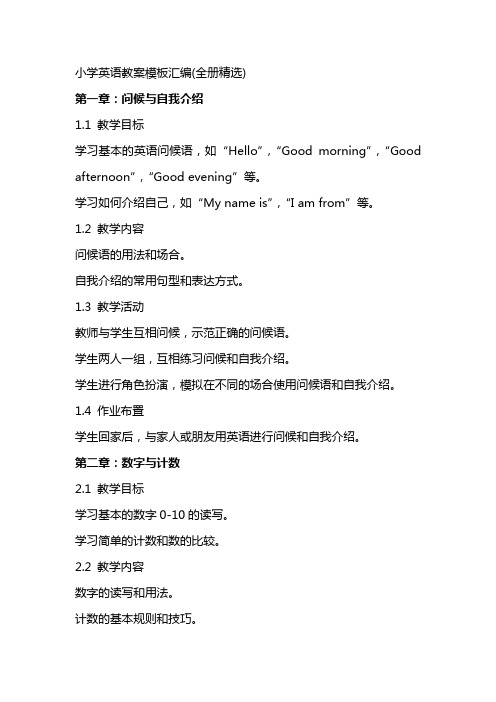
小学英语教案模板汇编(全册精选)第一章:问候与自我介绍1.1 教学目标学习基本的英语问候语,如“Hello”,“Good morning”,“Good afternoon”,“Good evening”等。
学习如何介绍自己,如“My name is”,“I am from”等。
1.2 教学内容问候语的用法和场合。
自我介绍的常用句型和表达方式。
1.3 教学活动教师与学生互相问候,示范正确的问候语。
学生两人一组,互相练习问候和自我介绍。
学生进行角色扮演,模拟在不同的场合使用问候语和自我介绍。
1.4 作业布置学生回家后,与家人或朋友用英语进行问候和自我介绍。
第二章:数字与计数2.1 教学目标学习基本的数字0-10的读写。
学习简单的计数和数的比较。
2.2 教学内容数字的读写和用法。
计数的基本规则和技巧。
教师引导学生学习数字0-10的读写。
学生进行数字卡片游戏,练习计数和数的比较。
学生分组进行数字接龙游戏,巩固数字和计数的掌握。
2.4 作业布置学生回家后,练习数字的读写,并尝试用英语进行简单的计数。
第三章:颜色与形状3.1 教学目标学习基本的颜色词汇,如“red”,“yellow”,“blue”等。
学习基本的形状词汇,如“circle”,“square”,“triangle”等。
3.2 教学内容颜色的分类和描述。
形状的分类和描述。
3.3 教学活动教师引导学生学习颜色词汇,并通过实物展示进行颜色识别练习。
学生进行颜色匹配游戏,巩固颜色词汇的掌握。
教师引导学生学习形状词汇,并通过实物展示进行形状识别练习。
学生进行形状拼图游戏,巩固形状词汇的掌握。
3.4 作业布置学生回家后,练习颜色和形状词汇的读写,并尝试用英语描述物品的颜色和形状。
第四章:家庭成员与职业学习基本的家庭成员词汇,如“mother”,“father”,“brother”等。
学习基本的职业词汇,如“teacher”,“doctor”,“engineer”等。
小学英语教案模板汇编(全册)
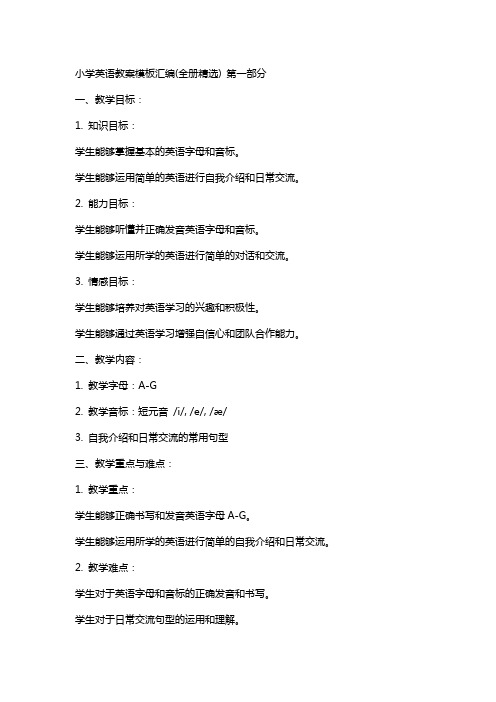
小学英语教案模板汇编(全册精选) 第一部分一、教学目标:1. 知识目标:学生能够掌握基本的英语字母和音标。
学生能够运用简单的英语进行自我介绍和日常交流。
2. 能力目标:学生能够听懂并正确发音英语字母和音标。
学生能够运用所学的英语进行简单的对话和交流。
3. 情感目标:学生能够培养对英语学习的兴趣和积极性。
学生能够通过英语学习增强自信心和团队合作能力。
二、教学内容:1. 教学字母:A-G2. 教学音标:短元音/i/, /e/, /æ/3. 自我介绍和日常交流的常用句型三、教学重点与难点:1. 教学重点:学生能够正确书写和发音英语字母A-G。
学生能够运用所学的英语进行简单的自我介绍和日常交流。
2. 教学难点:学生对于英语字母和音标的正确发音和书写。
学生对于日常交流句型的运用和理解。
四、教学方法与手段:1. 教学方法:直观演示法:通过实物和图片的展示,让学生直观地学习字母和音标。
情景教学法:创设真实的交流情境,让学生在实际情境中学习和运用英语。
互动教学法:引导学生参与课堂互动,增强学生的积极性和参与感。
2. 教学手段:多媒体教学:利用多媒体课件和视频,提供直观的学习资源。
实物教具:使用字母卡片和音标模型,帮助学生直观学习。
五、教学过程:1. 导入:利用歌曲或游戏引入英语字母和音标的学习,激发学生的兴趣。
2. 教学字母和音标:使用字母卡片和音标模型,进行直观演示,讲解发音和书写要领。
让学生跟随老师一起发音和书写,确保正确掌握。
3. 实践环节:分组进行角色扮演,让学生运用所学的自我介绍和日常交流句型进行对话。
提供一些实物或图片,让学生用英语描述和交流。
4. 总结与作业布置:对本节课所学内容进行总结,强调重点和难点。
布置作业:要求学生复习所学的字母和音标,并进行对话练习。
参考教材:人教版《小学英语》一年级上册小学英语教案模板汇编(全册精选) 第二部分1. 知识目标:学生能够掌握基本的英语数词和简单几何形状。
- 1、下载文档前请自行甄别文档内容的完整性,平台不提供额外的编辑、内容补充、找答案等附加服务。
- 2、"仅部分预览"的文档,不可在线预览部分如存在完整性等问题,可反馈申请退款(可完整预览的文档不适用该条件!)。
- 3、如文档侵犯您的权益,请联系客服反馈,我们会尽快为您处理(人工客服工作时间:9:00-18:30)。
小学英语教案模板汇编(全册精选)【对于英语学科专业在事业单位教师、普岗教师、昆明教师、特岗教师面试说课或试或教师资格试讲中,到底是使用全英文的,还是可以使用汉语的,是所有考试面试的学生所纠结的一个问题,育萃面试为您提供了不同的案例。
其实不在乎你使用什么形式的说课稿或教案,关键是你是否运用的熟练。
在面试考试中,注意】《Unit2 Colours》教案一、教学目标能正确把握表示颜色的单词。
二、教学重点、难点能正确把握表示颜色的单词。
三、教学预备颜色纸或各种实物、单词卡片四、教学过程step 1 revision1.教师出第一课时的三个句型认读。
2.t: what’s this?s: it’s a book.t: what are these?ss: books.t: how many books?s: ……t: is it blue?s: yes.t: is it red?s: no.继续换几种物品提问。
3.出示第二课时的句型订读。
step 2 presentation1.教师拿出红、绿两种颜色纸: what colour is it?复习巩固red/ blue,并且认读。
2.教师拿出黄色纸:is it red? is it blue?教学yellow。
教师拿出一片叶子教学green教师拿出一个自制的红绿灯教学一首小诗:red, red stop;yellow yellow wait;green green go go go!3. t show an orange: what’s this ? it’s an orange. what colour is it? it’s orange.t: orange is orange.4.show a peach:what colour is it? it’s pink.教学粉红色。
5. show a chocolate: what colour is it? it’s brown.教学棕色。
6.show a grape: what colour is it? it’s purple.教学紫色。
7.ss read togetherstep 3 consolidation1.listen to the tape, point and read.2.教师拿着各种颜色纸,让学生说英语。
3.play a game: 规则:将各种颜色纸放入一个口袋内,让他们猜一猜摸到的东西是什么颜色的,猜对的小朋友奖励。
4.read together5.让小朋友在教室里找一些颜色。
step 4 homeworkread the new words.《we love animals》教案一、教学目标1.知识目标(1)能听、说、读、写本单元的动物类单词。
(2)进一步巩固句型:Do you like...?Yes,I do./No,I don't.以及I like...和I don't like...2.能力目标能够用几句连贯的英文向别人介绍自己的动物朋友以及它的特征。
3.情感目标使学生认识到人与动物之间的亲密友好的关系,从而树立应该保护自然、爱护动物的意识。
二、教学重点能够听、说、读、写本课的动物类单词。
三、教学难点较熟练地在情景中运用几句连贯英文向别人介绍自己的动物朋友。
四、教学准备多媒体课件、动物实物、若干动物"名片"。
五、学情分析学生学习剑桥英语已有一年半之久,他们学习英语的兴趣浓厚,已具备交流简单个人信息的能力。
活泼爱玩,好表现自己是他们的天性。
We love animals 这一单元的主题是他们既熟悉又喜爱的动物,该课中的大部分动物单词学生已经学过,句型学生已熟练掌握,所以说学习这一课对于他们来说是件轻松愉快的事情。
六、教学过程1.Leading inT:Just now,we watched "The Lion King",do you like animals?What can you see?Which animals do you like?Do you like panda?2.Pre-task Preparation(1)Boys and girls,we are in the forest now,let's do some exercises.Listen and act.Hands up.Hands down.Act like a dog/cat/monkey.Fly like a bird.Swim like a fish.Jump like a rabbit.Run like a horse.Walk like an elephant.(2)CAI shows pictures of four animals tails.T:Look and guess.What animals are they?S:It's a dog/an elephant/a horse/a monkey.(3)CAI shows eight photos of animals.T:Look and say.What do you like?S:I like sheep...(4)Let's chant.Ss say the chant with T.I like sheep.I like goats.I like horses.I like dogs.I like chicks.I like ducks.I like cows.I like cats.(5)CAI shows a big apple tree.T:Now let's play a game.There are many apples on the tree,and each apple has a picture of an animal in back of it.I'll call one of you to pick an apple then write down this word on the blackboard.If it is right,I'll give you a smiling face.(6)Game:Find friends.①Give every S a card.②T gives a model.Sa:Do you like elephants?Sb:No,I don't like elephants.Sa:Do you like elephants?Sb:Yes,I like elephants.Sa:We're friends.③Ss free talk.④Check it up.Sa:We're friends because we like elephants.3.Post-task Activities(1)T:Do you know which animal I like best?Can you guess?T:(Show the toy giraffe and give the reasons.)Giraffe is my favourite animal.It is very pretty.It's very tall.It has got a small head,a long neck and a small tail.I like giraffes.Do you like giraffes?S1:Yes,I like giraffes.T:Great!This is for you.(Give her a smiling face.)(2)Activity:We love animals.(Show six toys:panda,monkey elephant,rabbit,snake,cat.)Divide the students into six groups,every group choose an animal,and discuss how to introduce it to others.①T gives the example.②Ss prepare in groups.③Communicate with the other group.e.g.S1:Hello!Look,this is a monkey.It's small.It's brown.It has a long tail.I like monkeys,because it is lovely and clever.Do you like monkeys?S2:Yes,I like monkeys.S1:Thank you.Goodbye.④Communicate with the teachers.T:There are many animals in the world,but we can't see some animals today and maybe they will never come back.Let's protect and save the animals.Do you love animals?T:Let's chant.Animals,animals,.Tigers,hippos,bears and pandas.We love animals,.Monkeys,horses,dogs and cats.Animals,animals,.4.HomeworkLook up some books after class and find out where the rare animals are both in and outside China,and then answer the follwing questions.(1)Where can we see pandas/elephants/tigers in China?(2)Where can we see hippos/crocodiles?【试讲或说课时如有学生,那么与学生互动的环节是不可少的了,教师在课堂上调动学生的积极性、提高学生学习兴趣是衡量教师的一个标准。
试讲者在互动环节要注意角色的把握,试讲者主要是发挥启发、引导学生的作用,而互动环节要以学生为主体,通过互动最终使学生达到充分理解课文重点内容和新课标要求的目的。
】《my classroom》教案一、教材分析my classroom主要让学生学会用所学教室相关的单词来描述自己的教室,注重学生语言运用能力的培养,在教材编排体系上贯穿“学会学习”(learn how to learn )的主题;注重培养学生学习英语的兴趣和自信心,话题贴近学生的生活实际,融合学科整合,重视灵活拓展,实现整体设计,让学生多方位达到运用语言的目的。
